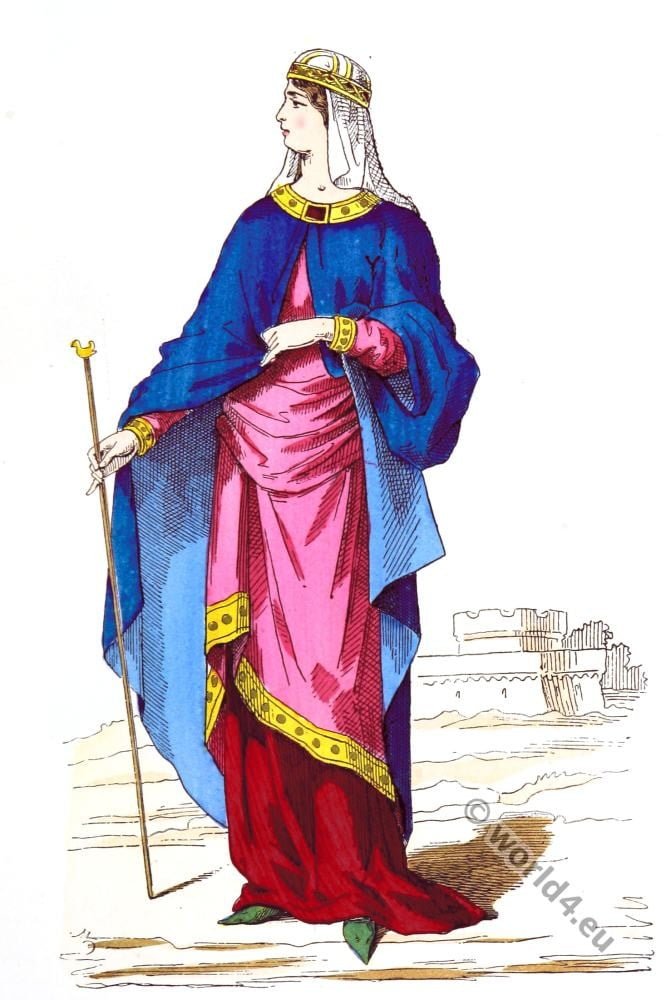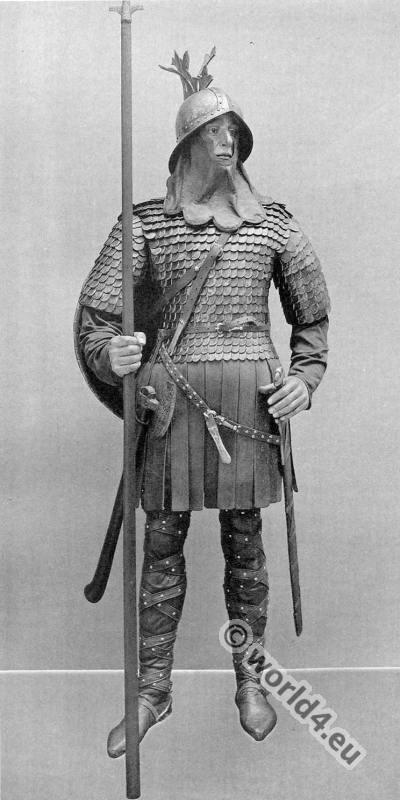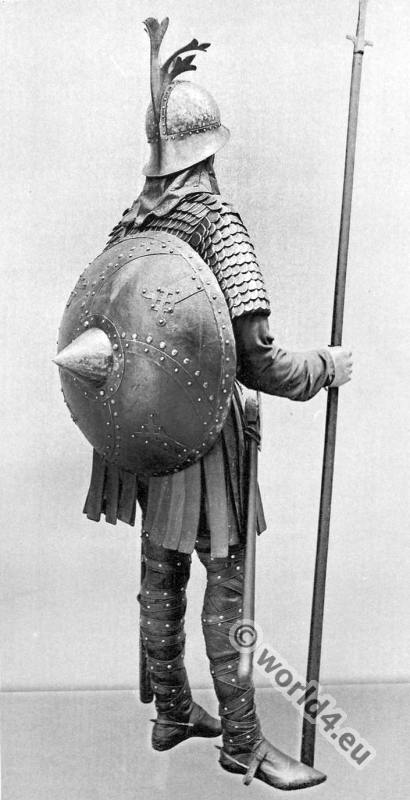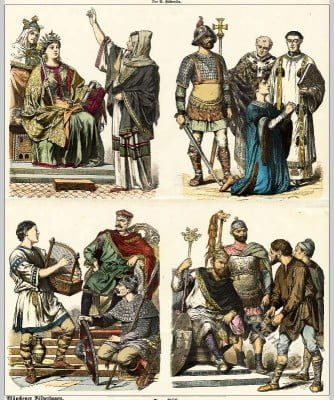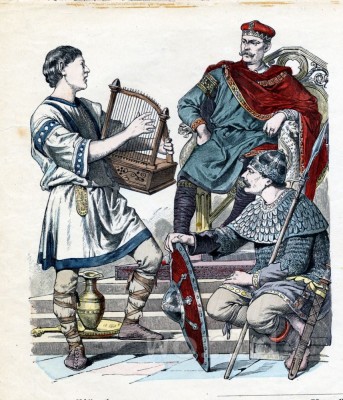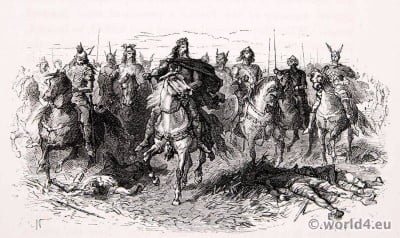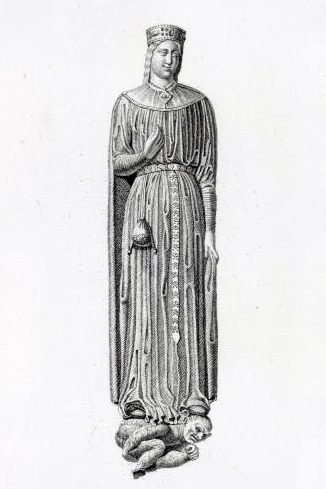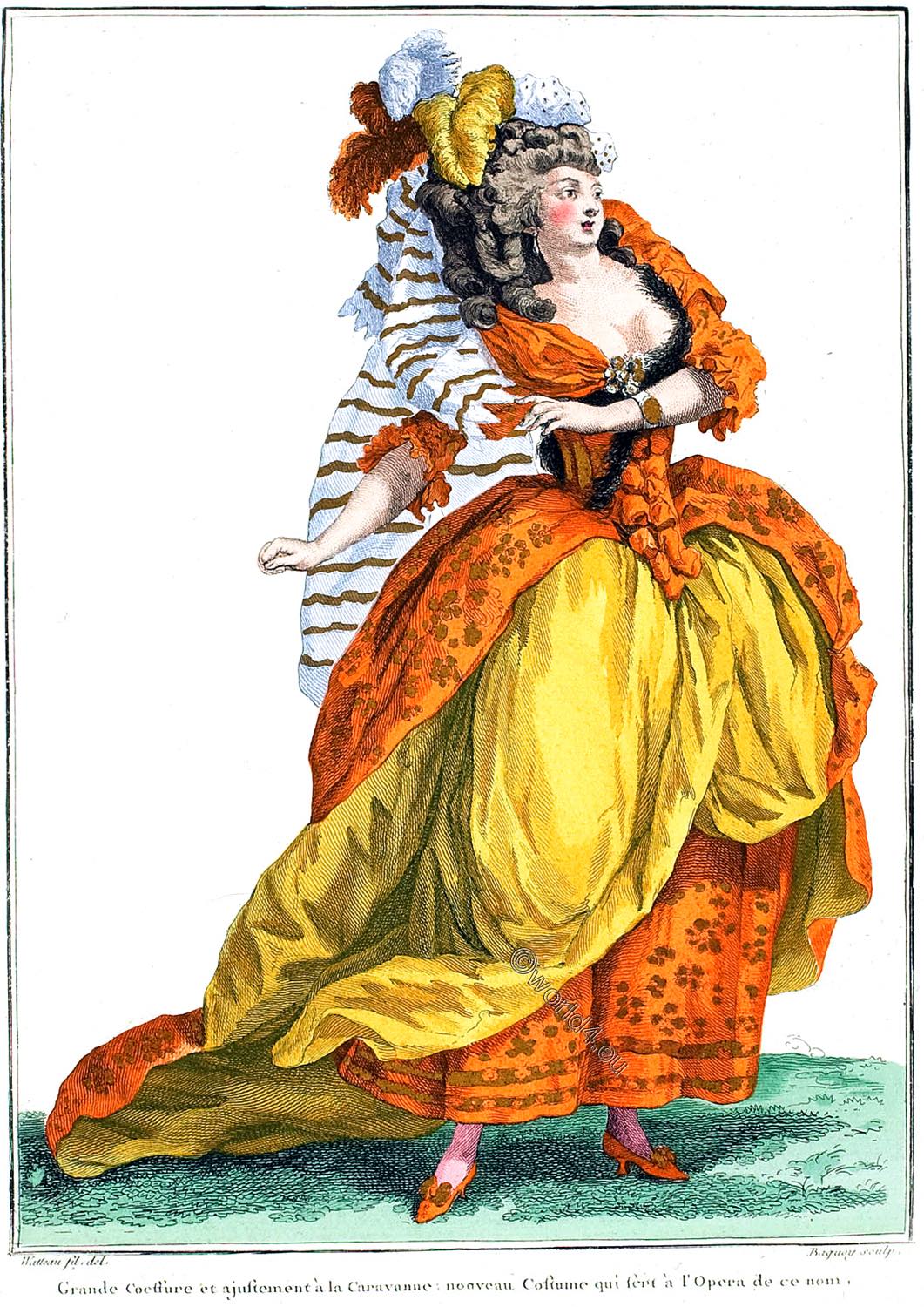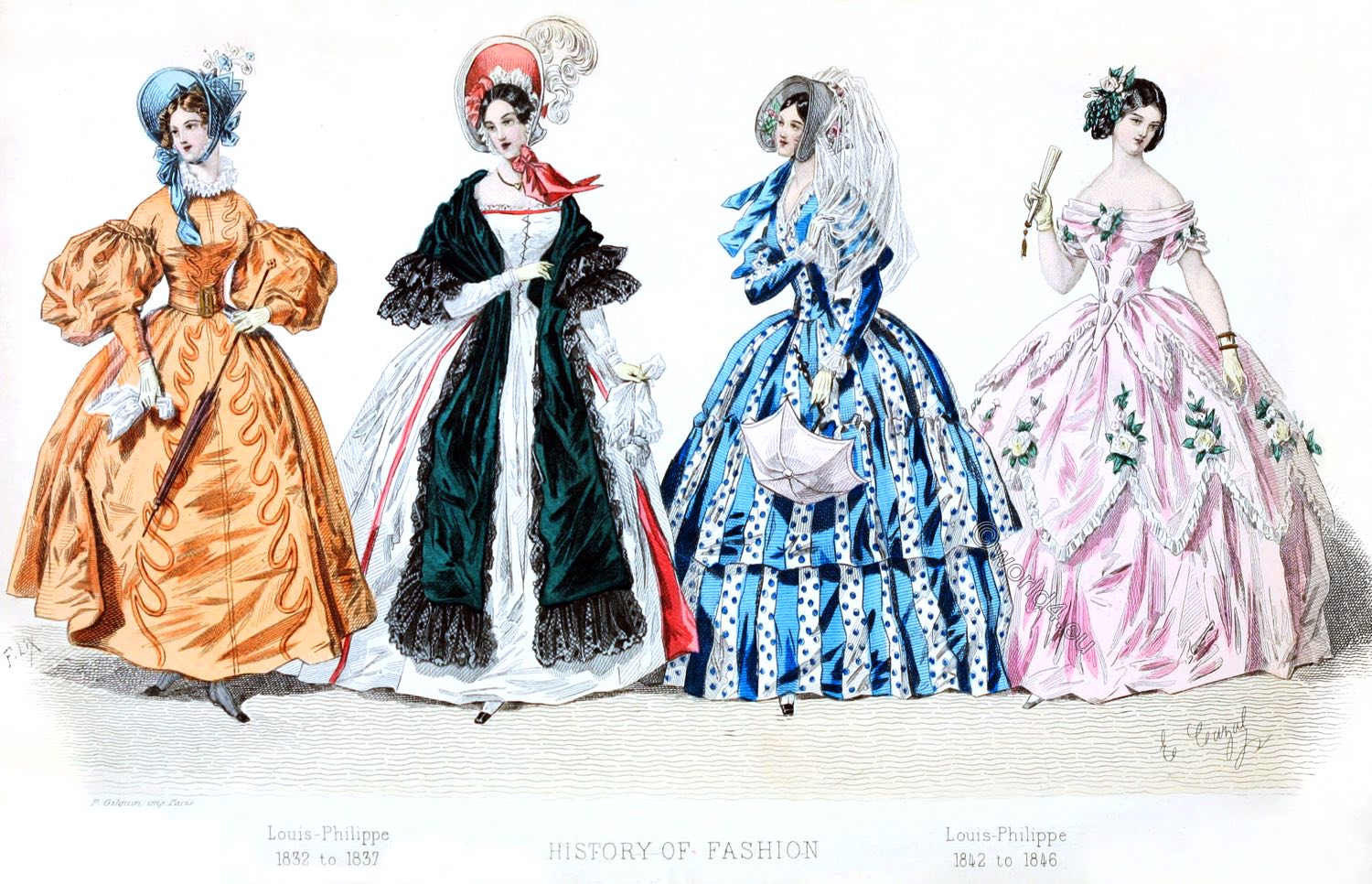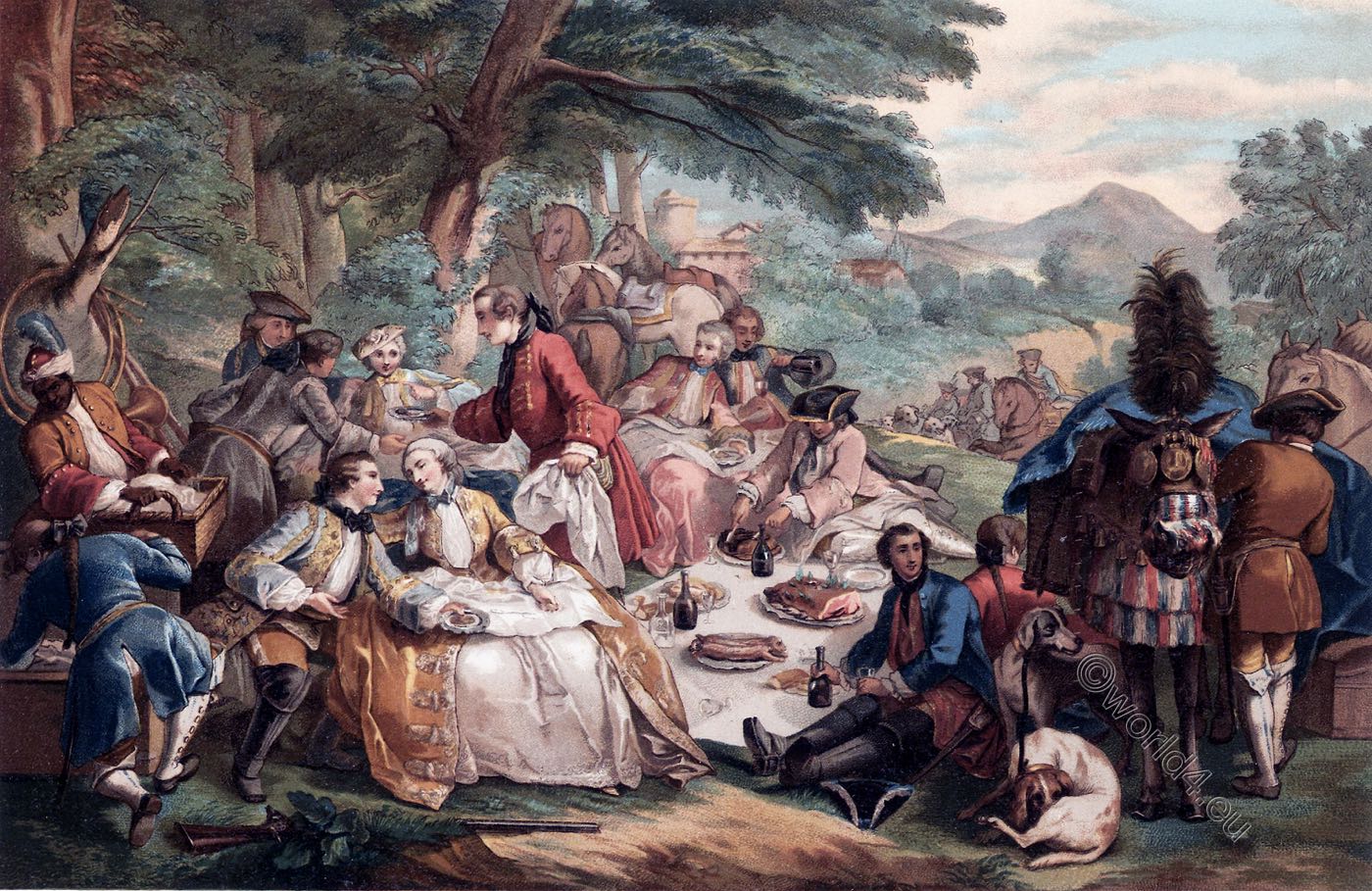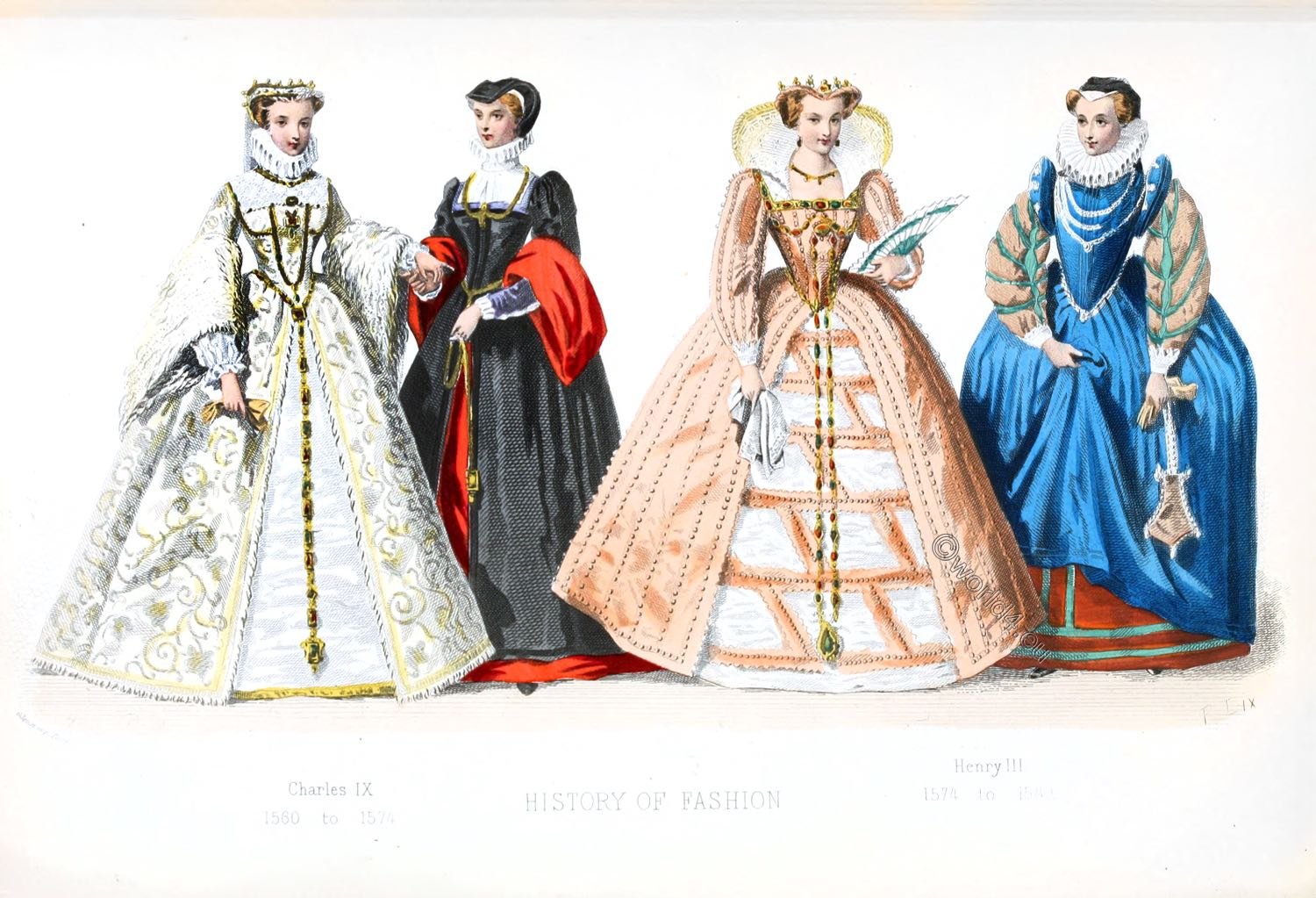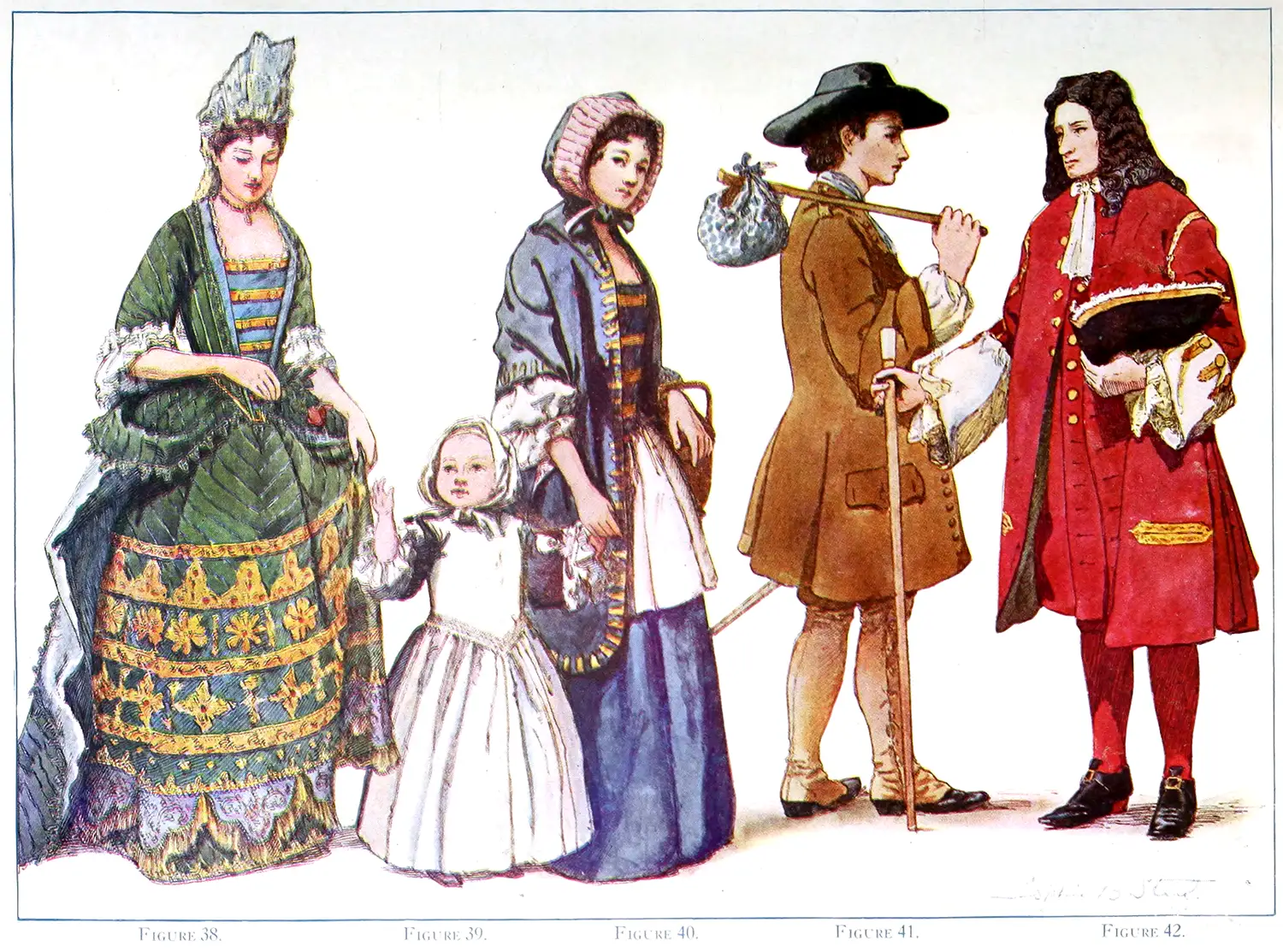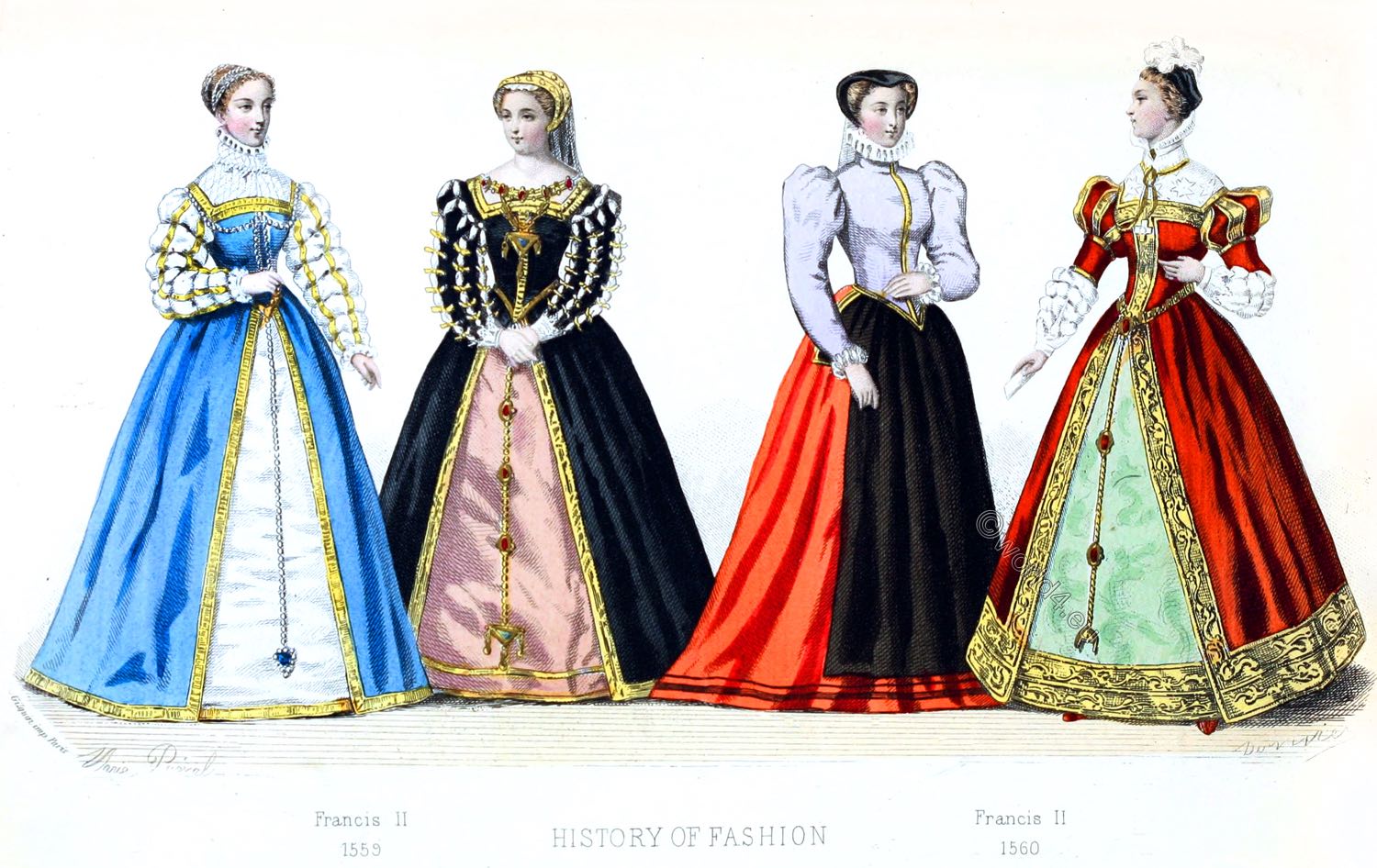
THE CAROLINGIAN PERIOD 752-987. Reign of Charlemagne.
Reign of Charlemagne – The women of the tenth century wear two tunics – Judith’s belt – A veil is obligatory – Miniatures in the Mazarin Library- Charles the Bald’s Bible Shoes – Dress of Queen Lutgarde – Dress of Rotrude and Bertha – Gisla and other kings women of the Emperor – The Successors of Charlemagne – Cannes – Adelaide of Vermandois – The dress of widows.

All illustrations of Charlemagne are taken from publications of the 19th century or earlier, as no contemporary portraits of Charlemagne have survived.
Reign of Charlemagne
THE reign of Charlemagne, and the passing away of the first race of our kings, to be succeeded by the second, made 110 essential difference as to dress. We cannot, in fact, ascribe much importance to the German and Byzantine influences which succeeded each other at that period, but did not destroy what we may denominate the Gallo-Roman style.
Tenth century. Two tunics. Judith’s belt.
The most elegant dress of a woman in the tenth century consisted of two tunics of different colors, one with long, the other with short sleeves; on the feet were boots laced up in front. Wide bands of embroidery bordered the throat, sleeves, and lower edge of the skirt. The waist-band was placed just above the hips.
This belt was generally of great value, being studded with gold and jewels. The belt belonging to Judith, wife of Louis le Dèbonnaire, weighed three pounds. At the present day there are no waist-bands either of that weight or value.
The Carolingian women wore splendidly embroidered veils, covering the head and shoulders, and reaching almost to the ground. This lent a character of severity to the costume, which was especially aimed at by the women of that period. The veil was indispensable, being regarded as the penalty of the sin of our Mother Eve, and the hair was concealed beneath it.

Reine Carlovinienne 7ème siècle. Costumes civils et militaires des Français à travers les siècles. 1883. Ouvrage couronné par l’Académie francaise. 
Femme de l’Époque Carolingienne vers 890 a 900. Costumes civils et militaires des Français à travers les siècles. 1883. Ouvrage couronné par l’Académie francaise.
Miniatures in the Mazarin Library
Among the admirable miniatures in the Mazarin Library (France’s First Public Library, The Bibliothèque Mazarine was initially the personal library of cardinal Mazarin (1602-1661, who was a great bibliophile), there is one of a queen wearing a triangular diadem, and a veil falling on either side over the shoulders. The under-tunic is black, the upper, in the style of a mantle, is violet. Both are bordered with yellow, her shoes are yellow also, and borderings and shoes alike were probably ornamented with gold. In the celebrated Bible of Charles the Bald, a most curious historical treasure, there are paintings of four women wearing the chlamys in different colors.
The chlamys is always white, with sleeves of gold brocade, with one exception, when it is rose-colored. The under-garments are bright orange, light brown, light blue, and violet, with pale blue sleeves, trimmed with strips of red embroidery on bands of a gold ground. We find that gold was used everywhere and always, and while making due allowance for the imagination of the artist, his pictures throw light on the costumes of the period. Observe that the four women all wear shoes, not boots. The historian has in general but scanty material with which to trace the dress of the princesses and ladies of the court under the Carolingian, on account of the many wars both civil and foreign that took place between the time of Charlemagne and that of Charles the Simple. Still less do we know concerning the dress of the women of the people, for on that point history is almost silent. We learn, however, that their skirts were extremely long, and that they wore veils much resembling the veil of nuns, but thicker, and hanging more closely round the figure.
Among women of noble rank the love of dress harmonized with the taste for needlework displayed by the kinswomen of Charlemagne, as recorded by the old chroniclers. They worked with their own hands on silk and wool, but this did not prevent them from loving and seeking to acquire magnificent possessions, splendid ornaments and trimmings of excessive richness. The Empress Judith, mother of Charles the Bald, was considered to have great skill in embroidery. She gave to her godchild, the Queen of Denmark, a gown made by herself and adorned with gold and gems. The ladies excelled in the manufacture of small articles, such as bags, scarfs, sleeves, and belts.
Dress of Queen Lutgarde
Narrow purple bands were plaited in Queen Luitgarde’s beautiful hair, and encircled her brow of dazzling fairness. Cords of gold held together her chlamys, a splendid mantle thrown over her right shoulder. A beryl, that clear and precious stone of bluish green, was set in her diadem. Her gown was of fine linen, dyed purple; her neck sparkled with jewels.
Rotrude, the eldest daughter of Charlemagne, wore a mantle with a clasp of gold and precious stones. Violet bands were plaited with her luxuriant fair hair. A golden coronet diapered with gems as beautiful as those in the clasp of her mantle encircled her brow, and gave her a truly queen-like look. Rotrude had been promised in marriage to the Emperor Constantine, who had heard of her beauty from beyond seas and mountains.
Bertha, another of Charlemagne’s daughters, who was married secretly to Angilbert, a disciple of Alcuin, and a member of the Palatine school, wore her hair confined in a golden fillet, and her head-dress was as impressive as that of her sister. Yellow-green chrysolites sparkled on the gold leaves with which her garments were embroidered.
Gisla, the best known of the great Emperor’s kinswomen, wore a purple striped veil, and a dress dyed with the stamens of the marsh-mallow or “mauve.”
Rhodaide rode on a superb horse; a gold bodkin set with jewels fastened her flowing silken chlamys. The mantle of Thèodrade was hyacinth, and trimmed with moleskin; beads of foreign fabric shone on her beautiful throat; on her feet she wore the Greek cothurnus, like the Byzantine women.
Such are the descriptions given us by writers of the period, from whom we also learn that the Carolingian ladies wore but one girdle, placed very low. The materials of their gowns were frequently transparent, revealing the shoulders, arms, and lower limbs, and the gowns themselves were somewhat clinging, so that the graceful undulating movement of the body was visible, as in the antique times.
These transparent materials disappeared by degrees under the successors of Charlemagne, and women’s dress became heavier and more ample. Long veils were worn.
Under the last Carolingians the splendor and elegance of female dress declined. Ladies began to wear extremely simple hoods and copes. They retained the habit of being delicately shod, shoes being for the most part black and embroidered in beads. Were they already aware of the important part played by shoes in the elegant appearance of a woman?
Carolingian ladies
Carolingian ladies frequently made use in their walks of a cane, ornamented at the top by a bird; the use of a stick lessening their fatigue and imparting uprightness to the figure.
If we may judge by the statue of Adelaide de Vermandois († 974), the widow of Count Geoffrey of Anjou, surnamed “Grisgonelle,” (“Greymantle”) who died in 987, the dress of aged women in the 10th century was somewhat as follows: A mantle was worn over a wide-sleeved gown, under which appeared another garment, with close-fitting sleeves, buttoning at the wrist. A “guimpe” covered the upper part of the bust, encircled the throat and was joined to the veil, which, arranged in two large pads over the ears, presented a strange appearance. We may conclude by saying that the women of that period preferred a rich but severe style of dress. Tightly fitting gowns displayed the slenderness of the waist. Their ornaments, sometimes of inestimable value, had none of the gaudiness that afterwards disfigured the dress of the noble court ladies. Intrinsic value in jewels was much appreciated, and they were worn, according to a Byzantine fashion, fastened to the dress of which they appeared to form part. For a long time past jewels had been worn attached to the sides of the circlet or coronet, and falling over the hair as low as the shoulders.
It is noticeable that the garb of widows resembled that of our nuns. Ten centuries have scarcely changed its principal characteristics. We learn from the romances of chivalry that to have the insteps of the hose cut open was a sign of mourning, and that damosels and the people of their suite would make a vow as a mark of mourning to put on their garments “the wrong side out.” Widows of the highest rank wore their gowns high up to the throat, and wrapped themselves in a veil. The fashion of their head-dress was an important point with Carolingian ladies. If of noble birth they wore their hair long, falling behind the ears over the shoulders, and reaching below the waist. It was curled and waved on the forehead. Their earrings were short pendants ending in a pearl.
Like the Germans, they united to a love of dress a love of cleanliness, and were accustomed to make use of the bath, either at the public establishments, or in their own villas, which were provided with every necessary for their daily wants.
In these respects certain customs of the East had rather gained than lost ground, and this in spite of the prohibitions of the Catholic Church, which sought to prevent scandals, or exaggerated practices hurtful to the public health. But it would be a great mistake to imagine that baths were taken during the Carolingian period in splendidly decorated halls like those of the Romans; statues, paintings, and mosaics were alike absent. The therm of Julian on the left bank of the Seine, of which the ruins remain to this day in the Hotel de Cluny on the Boulevards St. Michel and St. Germain, included gardens, porticoes, nay, even an immense palace, in which many kings and queens of the earliest race took up their abode, and in all probability made use of its baths.
Childebert (Childebert I, 497 – 558) was the fourth eldest son of the Merovingian Frankish king Clovis I, the third of his marriage to Chrodechild. In the imperial division of 511, he was part of the kingdom with the royal residence in Paris, and ruled until his death), for instance, set up his court there with Ultrogothe (Queen of Paris) and his daughters Chrodoswinth and Chrodoberga. But with these exceptions no Merovingian or Carolingian king has possessed baths of such size. It is almost certain that the great lords and ladies built no large bathing establishments in connexion with their private dwellings; on the other hand, their toilet apparatus, plate, brushes, fine towels, and other articles were often of very great value. The bath itself was of wood, marble, or stone. The public baths served as a place of meeting, where the news of the day might be ascertained, and business and pleasure discussed.
By Augustin Challamel.
Continuing
Related
Discover more from World4 Costume Culture History
Subscribe to get the latest posts sent to your email.


